+ Open data
Open data
- Basic information
Basic information
| Entry | Database: PDB / ID: 8bzb | ||||||
|---|---|---|---|---|---|---|---|
| Title | co-soak stabilizers for ERa - 14-3-3 interaction (884_AZ275) | ||||||
 Components Components |
| ||||||
 Keywords Keywords |  STRUCTURAL PROTEIN / STRUCTURAL PROTEIN /  14-3-3 / ERa / fragment linking / stabilization 14-3-3 / ERa / fragment linking / stabilization | ||||||
| Function / homology |  Function and homology information Function and homology informationregulation of epithelial cell apoptotic process / antral ovarian follicle growth / G protein-coupled estrogen receptor activity / regulation of branching involved in prostate gland morphogenesis / RUNX1 regulates transcription of genes involved in WNT signaling / RUNX1 regulates estrogen receptor mediated transcription /  regulation of toll-like receptor signaling pathway / regulation of epidermal cell division / prostate epithelial cord arborization involved in prostate glandular acinus morphogenesis / regulation of toll-like receptor signaling pathway / regulation of epidermal cell division / prostate epithelial cord arborization involved in prostate glandular acinus morphogenesis /  protein kinase C inhibitor activity ...regulation of epithelial cell apoptotic process / antral ovarian follicle growth / G protein-coupled estrogen receptor activity / regulation of branching involved in prostate gland morphogenesis / RUNX1 regulates transcription of genes involved in WNT signaling / RUNX1 regulates estrogen receptor mediated transcription / protein kinase C inhibitor activity ...regulation of epithelial cell apoptotic process / antral ovarian follicle growth / G protein-coupled estrogen receptor activity / regulation of branching involved in prostate gland morphogenesis / RUNX1 regulates transcription of genes involved in WNT signaling / RUNX1 regulates estrogen receptor mediated transcription /  regulation of toll-like receptor signaling pathway / regulation of epidermal cell division / prostate epithelial cord arborization involved in prostate glandular acinus morphogenesis / regulation of toll-like receptor signaling pathway / regulation of epidermal cell division / prostate epithelial cord arborization involved in prostate glandular acinus morphogenesis /  protein kinase C inhibitor activity / nuclear estrogen receptor activity / epithelial cell proliferation involved in mammary gland duct elongation / positive regulation of epidermal cell differentiation / epithelial cell development / keratinocyte development / protein kinase C inhibitor activity / nuclear estrogen receptor activity / epithelial cell proliferation involved in mammary gland duct elongation / positive regulation of epidermal cell differentiation / epithelial cell development / keratinocyte development /  keratinization / prostate epithelial cord elongation / negative regulation of smooth muscle cell apoptotic process / mammary gland branching involved in pregnancy / uterus development / vagina development / androgen metabolic process / TFIIB-class transcription factor binding / steroid hormone mediated signaling pathway / Regulation of localization of FOXO transcription factors / keratinocyte proliferation / phosphoserine residue binding / Activation of BAD and translocation to mitochondria / negative regulation of keratinocyte proliferation / mammary gland alveolus development / intracellular estrogen receptor signaling pathway / establishment of skin barrier / cellular response to estrogen stimulus / keratinization / prostate epithelial cord elongation / negative regulation of smooth muscle cell apoptotic process / mammary gland branching involved in pregnancy / uterus development / vagina development / androgen metabolic process / TFIIB-class transcription factor binding / steroid hormone mediated signaling pathway / Regulation of localization of FOXO transcription factors / keratinocyte proliferation / phosphoserine residue binding / Activation of BAD and translocation to mitochondria / negative regulation of keratinocyte proliferation / mammary gland alveolus development / intracellular estrogen receptor signaling pathway / establishment of skin barrier / cellular response to estrogen stimulus /  estrogen response element binding / SARS-CoV-2 targets host intracellular signalling and regulatory pathways / : / Chk1/Chk2(Cds1) mediated inactivation of Cyclin B:Cdk1 complex / intracellular steroid hormone receptor signaling pathway / negative regulation of canonical NF-kappaB signal transduction / negative regulation of stem cell proliferation / SARS-CoV-1 targets host intracellular signalling and regulatory pathways / Nuclear signaling by ERBB4 / RNA polymerase II preinitiation complex assembly / RHO GTPases activate PKNs / protein localization to chromatin / protein kinase A signaling / TBP-class protein binding / estrogen response element binding / SARS-CoV-2 targets host intracellular signalling and regulatory pathways / : / Chk1/Chk2(Cds1) mediated inactivation of Cyclin B:Cdk1 complex / intracellular steroid hormone receptor signaling pathway / negative regulation of canonical NF-kappaB signal transduction / negative regulation of stem cell proliferation / SARS-CoV-1 targets host intracellular signalling and regulatory pathways / Nuclear signaling by ERBB4 / RNA polymerase II preinitiation complex assembly / RHO GTPases activate PKNs / protein localization to chromatin / protein kinase A signaling / TBP-class protein binding /  steroid binding / TFAP2 (AP-2) family regulates transcription of growth factors and their receptors / protein export from nucleus / negative regulation of innate immune response / 14-3-3 protein binding / nitric-oxide synthase regulator activity / ESR-mediated signaling / protein sequestering activity / TP53 Regulates Transcription of Genes Involved in G2 Cell Cycle Arrest / release of cytochrome c from mitochondria / transcription corepressor binding / positive regulation of protein export from nucleus / negative regulation of miRNA transcription / cellular response to estradiol stimulus / stem cell proliferation / Translocation of SLC2A4 (GLUT4) to the plasma membrane / steroid binding / TFAP2 (AP-2) family regulates transcription of growth factors and their receptors / protein export from nucleus / negative regulation of innate immune response / 14-3-3 protein binding / nitric-oxide synthase regulator activity / ESR-mediated signaling / protein sequestering activity / TP53 Regulates Transcription of Genes Involved in G2 Cell Cycle Arrest / release of cytochrome c from mitochondria / transcription corepressor binding / positive regulation of protein export from nucleus / negative regulation of miRNA transcription / cellular response to estradiol stimulus / stem cell proliferation / Translocation of SLC2A4 (GLUT4) to the plasma membrane /  transcription coregulator binding / transcription coregulator binding /  stem cell differentiation / nuclear estrogen receptor binding / positive regulation of nitric-oxide synthase activity / TP53 Regulates Metabolic Genes / negative regulation of protein kinase activity / SUMOylation of intracellular receptors / stem cell differentiation / nuclear estrogen receptor binding / positive regulation of nitric-oxide synthase activity / TP53 Regulates Metabolic Genes / negative regulation of protein kinase activity / SUMOylation of intracellular receptors /  euchromatin / negative regulation of cysteine-type endopeptidase activity involved in apoptotic process / euchromatin / negative regulation of cysteine-type endopeptidase activity involved in apoptotic process /  transcription coactivator binding / negative regulation of DNA-binding transcription factor activity / transcription coactivator binding / negative regulation of DNA-binding transcription factor activity /  beta-catenin binding / Nuclear Receptor transcription pathway / positive regulation of DNA-binding transcription factor activity / response to estrogen / male gonad development / Regulation of RUNX2 expression and activity / Constitutive Signaling by Aberrant PI3K in Cancer / beta-catenin binding / Nuclear Receptor transcription pathway / positive regulation of DNA-binding transcription factor activity / response to estrogen / male gonad development / Regulation of RUNX2 expression and activity / Constitutive Signaling by Aberrant PI3K in Cancer /  nuclear receptor activity / positive regulation of nitric oxide biosynthetic process / intrinsic apoptotic signaling pathway in response to DNA damage / positive regulation of fibroblast proliferation / Ovarian tumor domain proteases / sequence-specific double-stranded DNA binding / response to estradiol / PIP3 activates AKT signaling / phospholipase C-activating G protein-coupled receptor signaling pathway / nuclear receptor activity / positive regulation of nitric oxide biosynthetic process / intrinsic apoptotic signaling pathway in response to DNA damage / positive regulation of fibroblast proliferation / Ovarian tumor domain proteases / sequence-specific double-stranded DNA binding / response to estradiol / PIP3 activates AKT signaling / phospholipase C-activating G protein-coupled receptor signaling pathway /  ATPase binding / positive regulation of cytosolic calcium ion concentration / ATPase binding / positive regulation of cytosolic calcium ion concentration /  regulation of inflammatory response / fibroblast proliferation / PI5P, PP2A and IER3 Regulate PI3K/AKT Signaling / positive regulation of cell growth / DNA-binding transcription activator activity, RNA polymerase II-specific / Estrogen-dependent gene expression / regulation of inflammatory response / fibroblast proliferation / PI5P, PP2A and IER3 Regulate PI3K/AKT Signaling / positive regulation of cell growth / DNA-binding transcription activator activity, RNA polymerase II-specific / Estrogen-dependent gene expression /  transcription regulator complex / Extra-nuclear estrogen signaling transcription regulator complex / Extra-nuclear estrogen signalingSimilarity search - Function | ||||||
| Biological species |   Homo sapiens (human) Homo sapiens (human) | ||||||
| Method |  X-RAY DIFFRACTION / X-RAY DIFFRACTION /  MOLECULAR REPLACEMENT / Resolution: 1.7 Å MOLECULAR REPLACEMENT / Resolution: 1.7 Å | ||||||
 Authors Authors | Visser, E.J. / Sijbesma, E. / Ottmann, C. | ||||||
| Funding support |  Netherlands, 1items Netherlands, 1items
| ||||||
 Citation Citation |  Journal: Angew.Chem.Int.Ed.Engl. / Year: 2023 Journal: Angew.Chem.Int.Ed.Engl. / Year: 2023Title: From Tethered to Freestanding Stabilizers of 14-3-3 Protein-Protein Interactions through Fragment Linking. Authors: Visser, E.J. / Jaishankar, P. / Sijbesma, E. / Pennings, M.A.M. / Vandenboorn, E.M.F. / Guillory, X. / Neitz, R.J. / Morrow, J. / Dutta, S. / Renslo, A.R. / Brunsveld, L. / Arkin, M.R. / Ottmann, C. | ||||||
| History |
|
- Structure visualization
Structure visualization
| Structure viewer | Molecule:  Molmil Molmil Jmol/JSmol Jmol/JSmol |
|---|
- Downloads & links
Downloads & links
- Download
Download
| PDBx/mmCIF format |  8bzb.cif.gz 8bzb.cif.gz | 113.1 KB | Display |  PDBx/mmCIF format PDBx/mmCIF format |
|---|---|---|---|---|
| PDB format |  pdb8bzb.ent.gz pdb8bzb.ent.gz | 85.1 KB | Display |  PDB format PDB format |
| PDBx/mmJSON format |  8bzb.json.gz 8bzb.json.gz | Tree view |  PDBx/mmJSON format PDBx/mmJSON format | |
| Others |  Other downloads Other downloads |
-Validation report
| Arichive directory |  https://data.pdbj.org/pub/pdb/validation_reports/bz/8bzb https://data.pdbj.org/pub/pdb/validation_reports/bz/8bzb ftp://data.pdbj.org/pub/pdb/validation_reports/bz/8bzb ftp://data.pdbj.org/pub/pdb/validation_reports/bz/8bzb | HTTPS FTP |
|---|
-Related structure data
| Related structure data | 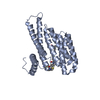 8bwjC 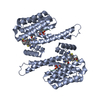 8bwxC 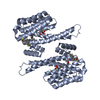 8bwzC 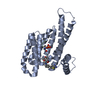 8bx0C 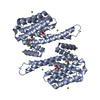 8bx3C 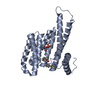 8bx4C 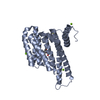 8bxiC  8bxmC 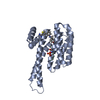 8bxnC 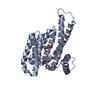 8bxoC 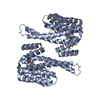 8bxqC 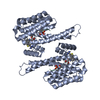 8bxsC  8by9C 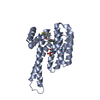 8bybC  8bycC 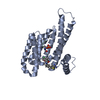 8bydC 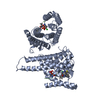 8byeC 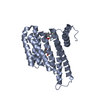 8byfC 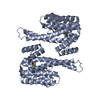 8bygC 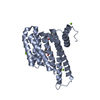 8byoC 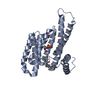 8byyC 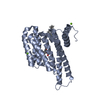 8byzC 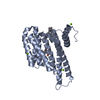 8bz0C 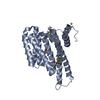 8bz9C 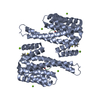 8bzaC  8bzwC  8c04C  8c0kC 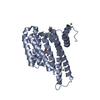 8c4fC 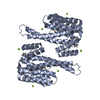 8c4gC C: citing same article ( |
|---|---|
| Similar structure data | Similarity search - Function & homology  F&H Search F&H Search |
- Links
Links
- Assembly
Assembly
| Deposited unit | 
| ||||||||
|---|---|---|---|---|---|---|---|---|---|
| 1 | 
| ||||||||
| Unit cell |
|
- Components
Components
-Protein / Protein/peptide , 2 types, 2 molecules AB
| #1: Protein | Mass: 26531.955 Da / Num. of mol.: 1 Source method: isolated from a genetically manipulated source Source: (gene. exp.)   Homo sapiens (human) / Gene: SFN, HME1 / Production host: Homo sapiens (human) / Gene: SFN, HME1 / Production host:   Escherichia coli (E. coli) / References: UniProt: P31947 Escherichia coli (E. coli) / References: UniProt: P31947 |
|---|---|
| #2: Protein/peptide |  / ER / ER-alpha / Estradiol receptor / Nuclear receptor subfamily 3 group A member 1 / ER / ER-alpha / Estradiol receptor / Nuclear receptor subfamily 3 group A member 1Mass: 613.596 Da / Num. of mol.: 1 / Source method: obtained synthetically / Source: (synth.)   Homo sapiens (human) / References: UniProt: P03372 Homo sapiens (human) / References: UniProt: P03372 |
-Non-polymers , 4 types, 314 molecules 






| #3: Chemical | | #4: Chemical | ChemComp-GEH / | #5: Chemical | ChemComp-SH9 / | #6: Water | ChemComp-HOH / |  Water Water |
|---|
-Details
| Has ligand of interest | Y |
|---|
-Experimental details
-Experiment
| Experiment | Method:  X-RAY DIFFRACTION / Number of used crystals: 1 X-RAY DIFFRACTION / Number of used crystals: 1 |
|---|
- Sample preparation
Sample preparation
| Crystal | Density Matthews: 2.65 Å3/Da / Density % sol: 53.54 % |
|---|---|
Crystal grow | Temperature: 277 K / Method: vapor diffusion, sitting drop Details: 0.095 M HEPES (pH 7.1), PEG400 (24% (v/v)), 0.19 M CaCl2 and 5% (v/v) Glycerol |
-Data collection
| Diffraction | Mean temperature: 100 K / Serial crystal experiment: N |
|---|---|
| Diffraction source | Source: SEALED TUBE / Type: RIGAKU MICROMAX-003 / Wavelength: 1.54187 Å |
| Detector | Type: DECTRIS PILATUS 200K / Detector: PIXEL / Date: Jun 23, 2017 |
| Radiation | Protocol: SINGLE WAVELENGTH / Monochromatic (M) / Laue (L): M / Scattering type: x-ray |
| Radiation wavelength | Wavelength : 1.54187 Å / Relative weight: 1 : 1.54187 Å / Relative weight: 1 |
| Reflection | Resolution: 1.7→66.21 Å / Num. obs: 31123 / % possible obs: 97 % / Redundancy: 5.8 % / CC1/2: 0.999 / Net I/σ(I): 28.7 |
| Reflection shell | Resolution: 1.7→1.73 Å / Num. unique obs: 1174 / CC1/2: 0.967 |
- Processing
Processing
| Software |
| ||||||||||||||||||||||||||||||||||||||||||||||||||||||||||||||||||||||||||||||||||||
|---|---|---|---|---|---|---|---|---|---|---|---|---|---|---|---|---|---|---|---|---|---|---|---|---|---|---|---|---|---|---|---|---|---|---|---|---|---|---|---|---|---|---|---|---|---|---|---|---|---|---|---|---|---|---|---|---|---|---|---|---|---|---|---|---|---|---|---|---|---|---|---|---|---|---|---|---|---|---|---|---|---|---|---|---|---|
| Refinement | Method to determine structure : :  MOLECULAR REPLACEMENT / Resolution: 1.7→40.95 Å / SU ML: 0.13 / Cross valid method: FREE R-VALUE / σ(F): 1.35 / Phase error: 18.02 / Stereochemistry target values: ML MOLECULAR REPLACEMENT / Resolution: 1.7→40.95 Å / SU ML: 0.13 / Cross valid method: FREE R-VALUE / σ(F): 1.35 / Phase error: 18.02 / Stereochemistry target values: ML
| ||||||||||||||||||||||||||||||||||||||||||||||||||||||||||||||||||||||||||||||||||||
| Solvent computation | Shrinkage radii: 0.9 Å / VDW probe radii: 1.11 Å / Solvent model: FLAT BULK SOLVENT MODEL | ||||||||||||||||||||||||||||||||||||||||||||||||||||||||||||||||||||||||||||||||||||
| Refinement step | Cycle: LAST / Resolution: 1.7→40.95 Å
| ||||||||||||||||||||||||||||||||||||||||||||||||||||||||||||||||||||||||||||||||||||
| Refine LS restraints |
| ||||||||||||||||||||||||||||||||||||||||||||||||||||||||||||||||||||||||||||||||||||
| LS refinement shell |
|
 Movie
Movie Controller
Controller



 PDBj
PDBj


















